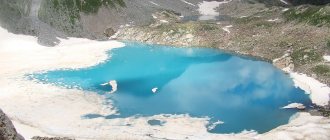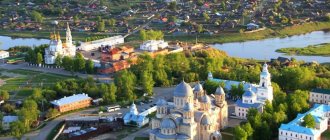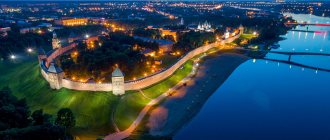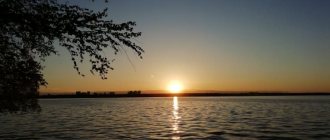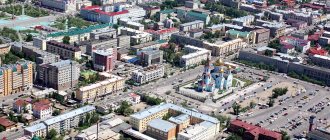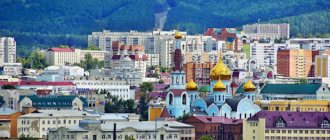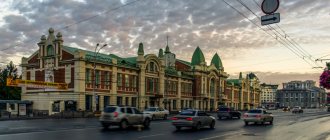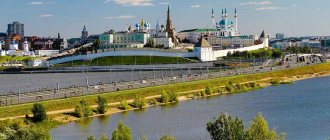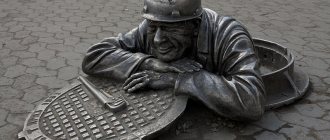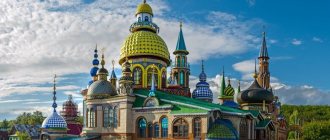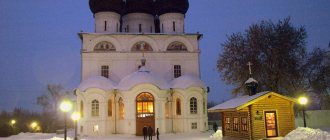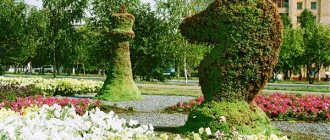Sights of Moscow. The most important and interesting sights of Moscow - photos and videos, descriptions and reviews, location, websites.
- Last minute tours
to Moscow
- Fine
Moscow, Kremlin, western sidethe very best
Alexander Garden
Fine
3 reviews
Moscow, Kremlin, western side
Along one of the walls of the Moscow Kremlin stretches the Alexander Garden - a place that has not lost its popularity since its founding. The garden was laid out according to the plan of the Commission for the construction of Moscow after the fire of 1812 on the site of the floodplain of the Neglinnaya River, enclosed in a pipe, and at first it was called the Kremlin Garden.
- Fine
Moscow, Kremlin, Armory Chamber
the very best
Diamond fund
Fine
3 reviews
Moscow, Kremlin, Armory Chamber
The Russian Diamond Fund is a collection of unique works of jewelry, rare precious stones and nuggets. Among the most significant exhibits of the Diamond Fund are the large and small imperial crowns, the imperial scepter with the Orlov diamond.
- Fine
Moscow, st. Arbat
the very best
Arbat
Fine
7 reviews
Moscow, st. Arbat
In every city with a long history there is such a street that attracts tourists like a magnet - imbued with a special spirit, with houses and alleys, each of which can tell its own interesting story. In Moscow, this is the well-known Arbat - one of the oldest streets in Moscow.
- Moscow Kremlin
the very best
Cathedral of the Archangel
Moscow Kremlin
In the 13th century, on the site of the cathedral there was a wooden church in the name of Archangel Michael. Under Ivan Kalita in 1333, a new white stone temple was built. The cathedral served as a tomb for the great princes until Peter I. Ivan I Kalita, Dmitry Donskoy, Vasily I and Vasily II and others are buried here.
- fabulous
Moscow, pl. Teatralnaya, 1
the very best
Grand Theatre
fabulous
2 reviews
Moscow, pl. Teatralnaya, 1
The Bolshoi Theater in Moscow is the main opera and ballet theater in Russia, well known outside our country. Traditionally, guests of the capital who come from abroad and regions of Russia go to the Bolshoi to enjoy productions of the highest level performed by leading artists.
- fabulous
Moscow, per. 5th Kotelnichesky, 11
the very best
Bunker-42 on Taganka
fabulous
2 reviews
Moscow, per. 5th Kotelnichesky, 11
Bunker-42 on Taganka is one of the most interesting and unusual museums in Moscow. It is located in a unique place - in the former secret military facility of the USSR ZKP Tagansky, or GO-42. The complex was built during the Cold War, in the 50s of the last century, and belonged to the Ministry of Defense.
- fabulous
Moscow, Mira Ave., 121
the very best
VDNH
fabulous
4 reviews
Moscow, Mira Ave., 121
The largest entertainment and educational complex in Russia, VDNKh, is located in the north-east of Moscow. Every day it attracts several thousand Muscovites and city guests. The exhibition features pavilions and fountains built in the pre-war Soviet era.
- fabulous
Moscow, st. m. Vorobyovy Gory, Vorobevskaya embankment
the very best
Sparrow Hills
fabulous
1 review
Moscow, st. m. Vorobyovy Gory, Vorobevskaya embankment
There are not many places in the city that participate in the life of almost every resident. Wedding processions come here, artists and writers admire the panorama of the city, schoolchildren celebrate their graduation here, students relax here and skiers train...
- average
Moscow, st. Prechistenka, 19
the very best
Zurab Tsereteli Art Gallery
average
1 review
Moscow, st. Prechistenka, 19
The Zurab Tsereteli Art Gallery in Moscow is a place that provides an excellent opportunity to get acquainted with the work of the famous sculptor and painter: many of his works are collected within these walls. The exhibition complex often hosts national and international exhibitions.
- fabulous
Moscow, st. m. Revolution Square, st. Ilyinka, 4
the very best
Gostiny Dvor in Moscow
fabulous
2 reviews
Moscow, st. m. Revolution Square, st. Ilyinka, 4
The situation “I went to the store and ended up in a museum” is quite typical for metropolitan life, because in Moscow every building is a monument of history and architecture. Here is Gostiny Dvor in the Mother See, as they say, “from the same opera.”
- Moscow, st. Prechistenka, 12/2
the very best
State Museum of A. S. Pushkin in Moscow
1 review
Moscow, st. Prechistenka, 12/2
The main exhibition is housed in an ancient building - the Khrushchev-Seleznyov estate, built after the Moscow fire of 1812. Now the building has been restored, the decoration from the time of Pushkin - the early 19th century has been preserved, which gives the museum a special atmosphere.
- Great
Moscow, st. m. Ploshchad Revolyutsii, Red Square, 3
the very best
GUM
Great
3 reviews
Moscow, st. m. Ploshchad Revolyutsii, Red Square, 3
GUM is one of the most famous department stores not only in Russia, but throughout the entire post-Soviet space. This is not only a fashionable shopping and entertainment complex, it is a real art object, and we are talking about both the internal content of GUM and its external appearance.
- Great
Moscow, st. m. Prospekt Mira, lane. Vasnetsova, 13
the very best
House-Museum of V. M. Vasnetsov
Great
1 review
Moscow, st. m. Prospekt Mira, lane. Vasnetsova, 13
Behind the forest of new buildings in the Meshchansky district of Moscow hides a magical hut - the House-Museum of V. M. Vasnetsov. Combining historical significance with cultural significance, this attraction has been attracting many tourists from various parts of Russia for several decades.
- Great
Moscow, pl. Donskaya, 1
the very best
Donskoy Monastery
Great
1 review
Moscow, pl. Donskaya, 1
There are few quiet places in Moscow. Donskoy Monastery is one of them. The bustle of the city does not penetrate behind the powerful walls. Peace and tranquility reign here, protected by linden alleys, an apple orchard and a strict cemetery. The main miracle in the history of the monastery is the unexpected discovery of the holy relics of St. Tikhon.
- Fine
Moscow, st. Tverskaya, 14
the very best
Eliseevsky store
Fine
2 reviews
Moscow, st. Tverskaya, 14
The Eliseevsky store was nicknamed the store-museum, the Hermitage store, the “Temple of Bacchus” (that was the name of the famous grocery store back in the early 20th century), be that as it may, one thing is clear - it is something grandiose, striking the imagination with its luxurious decoration, attracting not only the opportunity to buy, but also to look and see.
- Fine
Moscow, st. B. Gruzinskaya, 1
the very best
Zoo in Moscow
Fine
7 reviews
Moscow, st. B. Gruzinskaya, 1
The Moscow Zoo, the first zoo in the country, was opened in 1864 and was then called a zoo. Now it contains more than eight thousand animals belonging to more than a thousand species of the world's fauna. The zoo stands in the same place as it did 150 years ago and remains a favorite vacation spot for children and adults.
- Great
Moscow, Izmailovskoe highway, 73 Zh
the very best
Izmailovo Kremlin
Great
13 reviews
Moscow, Izmailovskoe highway, 73 Zh
The architectural ensemble of the Izmailovo Kremlin was created according to drawings and engravings of the royal residence of the 16th-17th centuries. The territory of the new Kremlin is rich in museums where you can take a unique journey into the past. This is a museum of Russian costume, a museum of bread, a museum of felt boots, a museum of bells, and a museum of fairy tales.
- Great
Moscow, Izmailovskoe highway
the very best
Izmailovsky Island
Great
3 reviews
Moscow, Izmailovskoe highway
Izmailovsky Island is an artificially formed island with a rich historical past. A ring of water and around it are two ponds and the Serebryanka river, which were once connected. The land that remained in the middle was called Izmailovsky Island after the owner of the village that stood in this place - Izmail.
- not bad
Moscow, Red Square, 1
the very best
Historical Museum in Moscow
not bad
9 reviews
Moscow, Red Square, 1
In the very heart of the capital, on Red Square, rises the building of the Historical Museum, the largest national museum in Russia, similar to an ancient Russian tower. The collection contains a huge number of exhibits (almost 4.5 million) telling about Russian history from ancient times to the present day.
- Great
Moscow, Andropova Ave., 39
the very best
Kolomna Palace
Great
2 reviews
Moscow, Andropova Ave., 39
The Palace of Tsar Alexei Mikhailovich in Kolomenskoye is a unique example of a historical building, completely recreated literally from scratch. The original Kolomna Palace was built in the 17th century as the hunting residence of Tsar Alexei Mikhailovich.
- 1
- …
- Next pageNext
For most tourists, Moscow is the Kremlin with its treasuries, Red Square and its surroundings, the Cathedral of Christ the Savior - interesting in its own way for both believers and atheists, the Tretyakov Gallery foray, the Bolshoi Theater - outside view, observation deck on Sparrow Hills, old Arbat and, perhaps, Victory Park.
And it doesn’t matter whether this tourist arrived by air from abroad or landed at one of the Moscow railway stations, having made his way to the capital from the Russian outback - the standard tour package is the same for everyone. But what will happen to you next depends only on the flight of your imagination. The good thing about Moscow is that an unpretentious traveler who has come for a couple of days, having driven around the city on a group sightseeing tour, will say: “Great, I’ve seen everything,” while another inquisitive Muscovite will find more and more protected places in the capital throughout his life . List all the sights of Moscow? Well, no, thank you! This is an inexhaustible topic. We will give you a vector, designate milestones, and then you yourself - find, learn, be surprised and have fun!
Moscow architecture
For those who like to read the history of the city through its buildings, Moscow will provide a lot of interesting material. The architectural sights of the capital are sometimes interesting in themselves, and often because of their rich history. It’s worth looking at the House on the Embankment, the dresser house, the egg house, Pertsov’s house next to the Cathedral of Christ the Savior, Pashkov’s house, Arseny Morozov’s house on Vozdvizhenka, which is completely atypical for Moscow. Numerous Moscow mansions reek of antiquity and echoes of the fates of their famous inhabitants. A special place in the Moscow panorama is occupied by Stalinist high-rise buildings, contrasting with tiny houses lost in the crooked alleys of the old center; or the dizzying skyscraper district of Moscow City.
Speaking about the architectural appearance of the capital, one cannot fail to mention the numerous churches and monasteries. This includes Saint Basil, who amazes with his unusual appearance even if you see him for the hundredth time, and the restored Kazan Cathedral on Red Square, and the Kremlin churches. A real pearl is the historical and architectural ensemble of the Novodevichy Convent. Moscow estates are rightfully considered open-air museums. The most beautiful of all, perhaps, is Kuskovo, and the most pompous is the renovated Tsaritsyno. In Kolomenskoye, pay attention to the Church of the Ascension of the Lord. Its slender silhouette with a tent-like finish is a popular symbol of Moscow and a UNESCO World Heritage Site.
Moscow on the move
Sights of Moscow: 50 most beautiful places in the capital
Moscow has thousands of historical and architectural monuments that deserve close attention. We have compiled a list of the most interesting sights of the capital, which will allow you to get to know and love this beautiful city. It is unforgivable to visit Moscow and not see at least a few places from this list.
Red Square The history of Russia's most famous square began in 1493, when a strip 240 meters wide was cleared under the Kremlin walls to increase trade space. Initially it was called Pozhar or Torg, then Trinity, since the Trinity Church stood in its southern part. Red Square became red after the construction of St. Basil's Cathedral. The modern appearance began to emerge in the second half of the 19th century, with the appearance of large-scale structures - the Middle and Upper Trading Rows, the building of the Historical Museum. The square acquired serious ideological weight after the revolution.
Sightseeing tour of Moscow
4 hours
Bus tour
We invite you to take a fascinating sightseeing tour of the capital on a comfortable bus. While developing this excursion program, our…
from 700
rub.
More details
Lights of night Moscow
4 hours
Bus tour
When the bustle of the day goes away and twilight falls on Moscow, the city becomes especially beautiful - the unusual and colorful illumination of many objects...
from 700
rub.
More details
Moscow Kremlin The fortress in the center of the capital has enormous historical, artistic and socio-political significance. The first wooden structures appeared here in 1264, when Moscow appanage princes built their residence on this territory. The Kremlin, as we know it now, began to take shape during the reign of Ivan III, when the Tsar decided to build a large-scale fortification structure on Borovitsky Hill. The ruler hired the most famous architects from Milan, and they fully lived up to the reputation of the best builders in Europe.
Legends of the Moscow Kremlin. Secrets of the underground city
2.5 hours
Hiking
Moscow is one of the most mysterious and extraordinary cities in the world. His biography is woven from dizzying ups and crushing falls,…
from 500
rub.
More details
Film studio "Mosfilm"
1.5 hours
An object
Experienced Mosfilm guides will be happy to introduce you to one of the largest and most advanced film studios not only in Russia, but also in Europe. Our…
from 1000
rub.
More details
GUM Modern GUM has taken the place of the Upper Trading Rows on Red Square. According to the architect's plan, New Rows was to become the most technically advanced and prestigious department store in the Russian style. Alexander Pomerantsev succeeded - a shopping complex with its own power plant, hairdressers, artesian wells, bank branches and other useful options created a sensation among the townspeople. GUM became a self-sufficient block of 16 separate buildings with streets and glass roofs. Today it is the most prestigious store in the country with an interesting history. ADDRESS:
Red Square, 3 (metro station Okhotny Ryad)
Cathedral of the Kazan Icon of the Mother of God on Red Square The temple was built in honor of the liberation of Moscow from Polish invaders in 1625. The cathedral received its name from the icon of Our Lady of Kazan - the main shrine of the people's militia. The church burned, was rebuilt, expanded. During the Soviet period, during the Stalinist reconstruction of Manezhnaya Square, the cathedral was dismantled. However, before this, the architect Baranovsky made measurements and photographed all the details of the temple. The initiative of a caring specialist made it possible, years later, to restore the building with maximum historical authenticity. ADDRESS:
Nikolskaya st., 3 (metro station Okhotny Ryad)
Iversky (Voskresensky) Gates The original Voskresensky Gates with two arches were built as part of the Kitaygorod wall in 1535 for a defensive purpose - they were intended to repel enemy attacks from advantageous positions. In 1556, Ivan the Terrible installed a cage with lions at the gate, donated by the King of England, after which the gate began to be called the Lion Gate. In 1669, a chapel was built above the gate specifically for the icon of the Iveron Mother of God. The Iveron Chapel was demolished in 1929, and a figure of a worker was erected in its place. In 1993, the gate was reconstructed and the chapel was restored to its original appearance. ADDRESS:
Voskresenskie Vorota Ave., 1A (metro station Okhotny Ryad)
State Historical Museum The date of establishment of the State Historical Museum is considered to be February 9, 1872. On this day, Alexander II signed the document on its foundation. This is how a majestic building appeared on Red Square, built specifically to house unique exhibits from the Russian treasury. Now in 39 halls all stages of the history of the state are presented - from the Stone Age to the present day. The total exhibition area is 4 thousand square meters; in total, the collections contain about 250 thousand exhibits. ADDRESS:
Voskresenskie Vorota Ave., 2 (metro station Okhotny Ryad)
Mausoleum of V.I. Lenin Six days after Lenin’s death, on the site of the stands from which the leader spoke to the proletarians, the architect Shchusev built the first wooden tomb in the shape of a cube with two extensions on the sides. In 1925, an international competition was held for the best design of a stone mausoleum, but the construction of a new tomb made of granite and labradorite was again entrusted to Shchusev. Construction was completed in 1930. The general idea of the stone mausoleum was reminiscent of an old building, but it was 4.5 times larger in area and three meters higher. ADDRESS:
Red Square (metro station Okhotny Ryad)
Lenin Mausoleum: secrets of the Kremlin necropolis
2 hours
Hiking
We invite you to take a journey into the past - to the era of the formation of the Soviet state. We will talk about the role of personality in history and the events...
from 500
rub.
More details
Moscow Embassies: mysteries and secrets of ancient mansions
2 hours
Hiking
Many noble estates located in the central regions of Moscow are placed at the disposal of foreign embassies. Although…
from 500
rub.
More details
St. Basil's Cathedral The most beautiful and recognizable temple in Russia was built and consecrated in 1561. The cathedral complex includes eleven chapels, which are grouped around the main Church of the Intercession of the Virgin. The Intercession Church was erected in memory of the annexation of Kazan, since the decisive battle with the army of the khan took place on the day of the Intercession of the Virgin. The remaining churches were also named after holidays on which important battles took place. St. Basil's Cathedral is a branch of the historical museum. The site is protected by UNESCO and included in the World Heritage List. ADDRESS:
Red Square, 7 (metro station Okhotny Ryad)
Nikolskaya Street The oldest Moscow street appeared on the city map in the 13th century, connecting the Kremlin with Vladimir, Suzdal and Rostov the Great. It acquired its name later, after the construction of the St. Nicholas the Old Monastery in 1390. Nikolskaya can easily be called the most progressive street in Moscow. It was here that the first printing house in Russia, the printing yard, opened its doors. Here Mstislavets and Fedorov created the first Russian book “Apostle” with imprint. The first secular school in Moscow and the Slavic-Greek-Latin Academy opened on Nikolskaya Street.
Zaryadye Park A new public space, created by a joint project of American and Russian urbanists in 2022, became the only facility in Russia included by Time magazine in its list of the best places to relax. In addition to organized natural areas, on the territory of Zaryadye there is a large philharmonic hall with almost 2 thousand seats, a hotel complex, a floating observation deck, an ice cave, well-maintained bicycle paths, numerous cafes and souvenir shops. ADDRESS:
st. Varvarka, 6 (metro station Kitay-Gorod)
Kitay-Gorod and Varvarka Street On the territory of Kitay-Gorod there is the oldest street in Moscow - Varvarka. The road to Vladimir began here, along which Dmitry Donskoy returned to the Kremlin after the Battle of Kulikovo. The first mention of the toponym dates back to 1434 - then the street was called differently - Varvarskaya. Now Varvarka begins at Red Square and ends at the Varvarsky Gate. But in ancient times the street ran along the ridge of the hill above the river from the Spassky Gate of the Kremlin. The modern appearance of Varvarka began to take shape after the fire of 1812, when burnt wooden buildings were replaced with stone buildings.
China Town: back to the past
2 hours
Hiking
Kitai-Gorod is one of the most ancient districts of Moscow. It is adjacent directly to the Kremlin and is not very large in size. But still China Town is...
from 500
rub.
More details
Moscow Merchant. Zamoskvorechye
2 hours
Hiking
Zamoskvorechye is an extraordinary area! This is a corner of old Moscow with narrow pedestrian streets, low houses, magnificent churches and…
from 500
rub.
More details
TSUM The history of TSUM began with the registration of the Muir and Merilize trademark by Scottish entrepreneurs in 1857. The first large store, which has no analogues in Russia, was opened under this brand. The commercial building burned down in 1900, but eight years later a new seven-story building in the neo-Gothic style appeared in its place. After the revolution, Muir and Meriliz was nationalized and, under the auspices of Mostorg, the largest department store was opened. In 1953, TSUM introduced a self-service system and installed cash registers, making it the most advanced department store in the Soviet Union. ADDRESS:
st. Petrovka, 2 (metro station Teatralnaya)
Bolshoi Theater The most significant theater in Russia was founded in 1776, when Prince Pyotr Urusov received permission from Catherine II to open and maintain a theater studio. The prince built a theater on Petrovka, but it immediately burned down. Urusov’s work was continued by Michael Maddox, thanks to whom a three-story building under a plank roof with a hall for a thousand seats appeared. But Maddox’s brainchild was also destroyed by fire. The fire did not spare the third theater, built in 1825, but it was restored, increasing the height, reworking the façade decor and changing the configuration - it is this option that has survived to this day. ADDRESS:
Teatralnaya Square, 1 (metro station Teatralnaya)
Moscow City Hall building (former house of the Governor General) The City Hall building was built in 1782 by the architect Kazakov by order of the Governor General of Moscow, Count Chernyshev. In 1790, after the death of the count, the palace in the classicist style became the official residence of Moscow leaders and served this function until 1917. After the revolution, the Moscow City Council was located in it, and in 1939, when Tverskaya Street was expanded, the house was moved to the new red line. In 1946, the building was reconstructed and enlarged, preserving the authentic architectural appearance, but adding Soviet symbols to the decor. ADDRESS:
Tverskaya st., 13 (Tverskaya metro station)
Patriarch's ponds The most mystical ponds in Moscow appeared in the 17th century near the Patriarch's settlement and the residence of Patriarch Hermogenes. Three small reservoirs were dug especially for breeding fish for the patriarchal table - the memory of this was preserved in the name of Trekhprudny Lane. With the abolition of the patriarchate, the fishponds became swampy, and in the first half of the 19th century, two of them were covered with earth, leaving one large Patriarchal pond, around which a cozy square was laid out. During the Soviet period, the decorative reservoir was called Pionersky; the first name returned only after 1990. ADDRESS:
Patriarch's Ponds (metro station Mayakovskaya)
Bulgakovskaya Moscow. Mysticism and reality
2 hours
Hiking
You cannot claim to know the capital if you are not familiar with Bulgakovskaya's Moscow. Mikhail Afanasyevich was not just a talented writer. He saw...
from 500
rub.
More details
Masonic Moscow. Legends and traditions of the “Freemasons”
2 hours
Hiking
The history and activities of the most mysterious world community are hidden from the general public. The veil of secrecy that covers everything related to Masonic...
from 500
rub.
More details
Pashkov House The famous white stone palace in the classicist style was supposedly built according to Bazhenov's design in 1786 and immediately gained fame as the most beautiful building in Moscow. The place for its construction was not chosen by chance - from the hill on which the mansion stands, all the buildings and towers of the Kremlin are visible. This is the only site with such a vista. In 1861, Pashkov’s house became the property of the Rumyantsev Museum, and the library was moved here. After the revolution, it received the status of the country's main book depository, and in 1992 it became the Russian State Library. ADDRESS:
st. Vozdvizhenka, 3/5с1 (metro station Borovitskaya)
Library named after Lenin The history of Leninka began in 1861, when the collection of rare books collected by Rumyantsev was transported from St. Petersburg to Moscow and placed in Pashkov’s house. The unique collection was replenished through gifts and donations, and by 1917 the funds already contained 1,200 thousand copies. Library named after Lenin was created on the basis of the Rumyantsev Museum in 1925. It included the Institute of Library Science and Graduate School. Gradually, the collection increased to 20 million copies, and Leninka acquired the most important scientific and research significance. ADDRESS:
st. Vozdvizhenka, 3/5 (metro station Borovitskaya)
Film studio "MOSFILM" The most famous film studio turned 95 years old. The first Soviet film “On Wings High” was shot here and more than 2.5 thousand films were created, many of which became classics. Outstanding directors worked at Mosfilm: Eisenstein, Pudovkin, Chukhrai, Pyryev, Bondarchuk, Ryazanov and many others. Now on the territory of the film factory there is a museum with unique exhibits. The exhibitions include scenery from famous films, historical costumes, personal items that belonged to great actors, and a collection of vintage cars. ADDRESS:
st. Mosfilmovskaya, 1 (metro station Lomonosovsky Prospekt)
Cathedral of Christ the Savior and Patriarchal Bridge The Cathedral of Christ the Savior was founded in honor of the victory over Napoleon's army in 1812. The best craftsmen of their time worked on the design of the grandiose building in the Russian-Byzantine style. The majestic cathedral was destroyed in 1931 and rebuilt in 1997 with maximum historical accuracy. In 2004, the Patriarchal Bridge was opened, connecting the territory of the temple with the Yakimanskaya, Bersenevskaya and Prechistenskaya embankments. From the surface of the arched structure there are excellent views of the Kremlin, the Peter the Great monument, the Moscow River and the central part of the city. ADDRESS:
st. Volkhonka, 15 (metro station Kropotkinskaya)
Cathedral of Christ the Savior with a visit to 4 observation platforms
2 hours
Hiking
The Cathedral of Christ the Savior is an Orthodox shrine and one of the main symbols of Moscow. This recreated architectural masterpiece represents…
from 800
rub.
More details
Masonic Moscow. Legends and traditions of the “Freemasons”
2 hours
Hiking
The history and activities of the most mysterious world community are hidden from the general public. The veil of secrecy that covers everything related to Masonic...
from 500
rub.
More details
Museum of Fine Arts. Pushkin The largest museum of foreign art was founded by Professor Ivan Tsvetaev in 1912. A building in the form of an antique temple in the neoclassical style was built specifically to house the large exhibition, designed by Roman Klein. According to the creator's plan, the enterprise was supposed to perform a teaching function, but after the revolution the institution was transformed into the State Museum. Now the collection includes about 800 thousand exhibits: works of fine art, archaeological finds, casts of ancient statues, objects from Ancient Rome and Egypt. ADDRESS:
st. Volkhonka, 12 (metro station Kropotkinskaya)
Theatrical tour “Ghosts and Witches of Moscow” with Count Saint-Germain
4 hours
Bus tour
We invite everyone who is interested in unusual phenomena and believes in the existence of the otherworldly to go on an exciting journey through the most…
from 800
rub.
More details
In the footsteps of Moscow ghosts
2 hours
Hiking
If you love mysticism and secrets, or perhaps you have a cherished desire, then you definitely need to visit the walking tour “In the Footsteps of...
from 500
rub.
More details
Novodevichy Convent One of the most beautiful monastery complexes in Russia was founded in 1524 by decree of Vasily III in honor of the capture of Smolensk. The architectural ensemble includes 14 buildings and a necropolis adjacent to the southern wall, where many representatives of noble families and prominent figures of the Soviet era were buried. The uniqueness of the Novodevichy Convent lies in its preservation. The appearance, formed in the 16th-17th centuries, has not undergone significant changes, which served as the basis for including the site on the UNESCO protected list. ADDRESS:
Novodevichy Ave., 1 (Sportivnaya metro station)
Novodevichy Convent with a visit to the Novodevichy Cemetery
2 hours
Hiking
The Novodevichy Convent is one of the most beautiful and most famous architectural and historical monuments in Moscow. The holy monastery, built in 1524...
from 700
rub.
More details
Legends and myths of Stalin's skyscrapers
3 hours
Bus tour
Majestic multi-storey buildings with sharp spiers are clearly visible from many points in the capital. These are Stalinist skyscrapers - a symbol of the Soviet era, one of...
from 700
rub.
More details
Vorobyovy Gory Vorobyovy Gory is part of a complex of seven Moscow hills and is one of the most picturesque areas of the capital. The main attraction of these places is the observation deck, which offers an amazing view of the city. Lermontov, Tolstoy, Dostoevsky, Blok and Bulgakov looked for inspiration here. Now, according to tradition, wedding processions come here. On Vorobyovy Gory there is a nature conservation park with an ecological trail, a cable car that operates all year round, and ski slopes with jumps and a chair lift. ADDRESS:
Vorobyovy Gory (Vorobyovy Gory metro station)
Luzhniki Stadium Luzhniki is on the list of the most capacious European stadiums - the sports facility can accommodate 81 thousand spectators at a time. During the World Cup, it was the main arena of the country. Now Luzhniki is one of the most popular attractions in Moscow. An observation deck is equipped on the roof of the stage, from which there is an excellent perspective on the Sparrow Hills and other interesting objects. There is also a giant media screen installed here. ADDRESS:
st. Luzhniki, 24, building 1 (metro station Vorobyovy Gory)
Moscow State University named after M.V. Lomonosov Moscow State University was founded in 1755 on the initiative of Shuvalov and Lomonosov. The oldest and largest university in Russia includes 15 research institutes, seven branches, approximately 300 departments, and 43 faculties. Now the university has more than 600 buildings, but its “heart” is located in one of the seven Stalinist towers on Sparrow Hills. This structure is the tallest in the complex - the distance from the foundation to the tip of the spire is 240 meters. Until the early 2000s, the building was the tallest European building. ADDRESS:
Leninskie Gory microdistrict, 1 (University metro station)
Hotel "Ukraine" Hotel "Ukraine" (now owned by the Radisson Collection chain) occupies the last of seven Stalinist skyscrapers on Kutuzovsky Prospekt. Outstanding architects of their time worked on the creation of a complex of three buildings, using the design technology of American skyscrapers as a basis. In 2005, the high-rise building was purchased and restored, preserving the architectural style and authentic decorative elements of the facades. During the renovation process, the new owners left the interiors of public spaces, halls, restaurants, staircases and lobbies unchanged. ADDRESS:
Kutuzovsky Ave., 2/1с1 (Kyiv metro station)
Residential building on Kotelnicheskaya Embankment The first of Stalin's seven high-rise buildings became the most famous residential building in Russia. Its architecture and luxurious decoration of the facades amaze the imagination, but the history of the building and its residents is of particular interest. The house immediately became a symbol of success, and the lists of the first owners of luxury real estate were approved by Stalin himself. Honored artists and NKVD employees stopped by already furnished apartments with crystal chandeliers, imported sanitary ware, expensive parquet flooring, but absolutely identical interiors. The fate of many of the first residents was tragic. ADDRESS:
Kotelnicheskaya embankment, 1/15 (metro station Kitay-Gorod)
The building of the Ministry of Foreign Affairs of the Ministry of Foreign Affairs occupies one of the most interesting Stalinist skyscrapers. Its difference from the six “sisters” lies in the principle of construction. The building, designed by architects Minkus and Gelfreich, was erected from top to bottom, first assembling the frame, and then concrete it and going down from the highest level to the foundation. The style in which the facades are designed only vaguely resembles a typical Soviet Empire style. The beautiful building is similar to the American Woolworth Building, decorated in the spirit of English Gothic. The decor lacks the flowerpots and towers characteristic of Stalinist houses, but does have merlons (merlons). ADDRESS:
Smolenskaya-Sennaya sq., 32/34 (metro station Smolenskaya)
Residential building on Kudrinskaya Square. The Stalin skyscraper on Kudrinskaya Square is a striking example of the Soviet Empire style. The house differs from the other six buildings in the abundance of decorative elements, but there is no single stylistic solution in its design. The designers used elements characteristic of Russian architecture, ancient Roman and Gothic architecture. The spire is surrounded by turrets reminiscent of the domes of Orthodox churches, and the sculptures on the risalits refer to the ancient Greek tradition. Despite the mixture of many directions, the appearance of the high-rise building is surprisingly harmonious and noble. ADDRESS:
Kudrinskaya sq., 1 (metro station Barrikadnaya)
An administrative and residential building near the Red Gate. The Stalinist high-rise building of three buildings looks more restrained than the other six buildings. Its decoration lacks luxurious materials, picturesque panels and marble statues, but the residential blocks were originally designed with rooms for servants. The house was incredibly technologically advanced for its time: centralized air conditioning and dust removal systems were implemented here, the kitchens of the apartments were equipped with sinks with a waste crushing function, built-in furniture and refrigerators. But the uniqueness of the high-rise is that the exit from the Krasnye Vorota metro station is located in its left wing. ADDRESS:
Sadovaya-Spasskaya st., 21/1 (Krasnye Vorota metro station)
Hotel "Leningradskaya" Hotel "Leningradskaya" (Hilton Moscow Leningradskaya) occupies the lowest Stalinist high-rise building - only 139 meters with a spire. The design is dominated by medieval Russian style, the central section refers to the Kremlin towers, the main entrance resembles the porch of a boyar's tower. The facade is decorated with intricate pediments, multi-profile cornices, pinnacles and hanging weights. The Russian style also dominates the interiors: the hall in the shape of an altar bowl is decorated with Shoksha porphyry and gold smalt, the lobby is divided into zones by a copy of the golden gates of the Verkhospassky Cathedral. ADDRESS:
Kalanchevskaya st., 21/40 (metro station Komsomolskaya)
State Tretyakov Gallery The Tretyakov Gallery was founded in 1856 by the merchant and philanthropist Tretyakov. In 1892, along with a collection of two thousand works of art, the gallery was transferred to the ownership of the city. After the revolution, the exhibitions were replenished with confiscated private collections. Now the collection of the New Tretyakov Gallery, combined with the State Art Gallery, includes almost 200 thousand items, including works by famous artists, unique jewelry, and sculptures. The exhibitions are located in an ancient building, which is a cultural heritage site. ADDRESS:
Lavrushinsky lane, 10 (Tretyakovskaya metro station)
VDNKh VDNKh is the world's largest museum, recreational and exhibition complex, one of the most popular public spaces in the capital. On its territory of 325 hectares there are 49 cultural heritage sites. Every year, 33 million people visit the Exhibition of National Economic Achievements. Conceptually, the Exhibition space is divided into seven zones: landscape park, theme park, Museum City, knowledge park, craft park, Ostankino park, EXPO zone. ADDRESS:
ave. Mira, 119 (metro station VDNH)
Ostankino TV Tower The Ostankino Tower has long outgrown its intended purpose, turning into a popular Moscow landmark and an interesting excursion object. On the territory of the legendary TV tower there is a museum with a unique exhibition dedicated to the construction and functionality of the tower; there are three observation platforms from which incredible panoramic views of the city open. The three-level restaurant “7 SKY”, rotating around its axis, attracts visitors with delicious cuisine and unusual interiors. ADDRESS:
st. Academician Korolev, 15, bldg. 1 (metro station VDNH)
Museum-Reserve "Kolomenskoye" The natural landscape and historical-architectural museum complex is divided into three large-scale zones: the village of Kolomenskoye with ancient parks and gardens, a museum of wooden architecture and buildings of the Sovereign's courtyard; the territory of the Durasov estate of the early 19th century in Lyublino; historical and cultural monument of park art of the 18th-19th centuries of the Izmailovo estate. In 2010, the palace of Alexei Mikhailovich was rebuilt in Kolomenskoye, consisting of 270 rooms and 26 towers. ADDRESS:
ave. Andropova, 39, building 46 (metro station Kolomenskaya)
Mystical Kolomenskoye
2 hours
Hiking
We invite you to visit one of the most mystical places in Moscow - the Kolomenskoye Museum-Reserve - together with our guide. “Oh, come on, what...
from 500
rub.
More details
Tsarskoye Tsaritsyno
2.5 hours
Hiking
We invite you to a fascinating walking tour through one of the most majestic palace and park ensembles of the capital - the museum-reserve...
from 500
rub.
More details
Tsaritsyno Museum-Reserve The Tsaritsyno palace and park complex is a unique example of Russian Gothic, created by the best architects of their time - Bazhenov and Kazakov. The museum-reserve was founded in 1776 by decree of Catherine II, who wanted to establish a country residence on the site of the estate of the Kantemirov princes. The Empress quickly lost interest in her project, but work continued. The Tsaritsyn architectural ensemble is designed in the same style and includes several palaces, luxurious outbuildings, amazingly beautiful bridges, gazebos and galleries. ADDRESS:
st. Dolskaya, 1 (metro station Tsaritsyno)
Museum-estate "Kuskovo" The museum-estate is located in the east of the capital, on the territory of the estate of the Sheremetev family. “Kuskovo” includes an 18th-century mansion in the neoclassical style, a park area with ancient sculptures, pavilions and small architectural forms, a ceramics museum and the Church of the All-Merciful Savior. The front part has survived to this day practically unchanged. The Sheremetev Palace has preserved its original layout and decor, portraits of representatives of several generations of estate owners, works of applied and fine art by Russian and European masters. ADDRESS:
st. Yunosti, 2, building 1 (metro station Novogireevo)
Cathedral of the Immaculate Conception of the Blessed Virgin Mary The largest Catholic church in Russia in the neo-Gothic style was built in 1911 by the Polish architect Bogdanovich-Dvorzhetsky. The building bore a resemblance to Westminster Abbey, but was more beautiful than its prototype. The temple operated until 1938, then the authorities closed it, the property was nationalized, and the premises were rebuilt into a dormitory. During the Second World War, the cathedral was damaged by bombing; in 1956, the building was restored and transferred to the Mosspetspromproekt Research Institute. After reconstruction in 1999, the church was reconsecrated and regular services resumed. ADDRESS:
st. Malaya Gruzinskaya, 27/13, building 1 (metro station Ulitsa 1905 Goda)
House of the Government of the Russian Federation The White House is an administrative building with a relatively short but colorful history. In August 1991, during the coup, this was the center of resistance to the State Emergency Committee. In the fall of 1993, during the political conflict, the house was seriously damaged by tank shells; several floors were completely burned out. The administrative complex was built to house the Supreme Council of the RSFSR and the People's Control Committee according to the project of Dmitry Chechulin in 1965-1981. After the events of the early 90s, it was restored and transferred to the Russian government. ADDRESS:
Krasnopresnenskaya embankment, 2 (metro station Krasnopresnenskaya)
Poklonnaya Gora Poklonnaya Gora is a large memorial park founded in memory of the victims of the Great Patriotic War. The total area is 135 hectares. On the territory of the complex there is a grandiose obelisk almost 142 meters high, three temples, monuments to “All the Fallen” by Znob and “Defenders of the Russian Land” by Bichug, a statue of St. George the Victorious and a bronze figure of Nike (Tsereteli), the Central Museum of the Great Patriotic War with a unique collection consisting of 50 thousands of exhibits. In 2010, an eternal flame was lit on Poklonnaya Hill.
Triumphal Gate on Kutuzovsky Prospekt Triumphal Gate on Tverskaya Zastava Square was built in 1814 in honor of the victory over Napoleon. In 1834, the arch was replaced by a stone structure designed by Beauvais. In 1936, the structure was dismantled and moved to the courtyard of the Donskoy Monastery. In 1958, the arch was assembled in a new place - on Kutuzovsky Prospekt. After dismantling, many details of the gate were lost, so the columns, high reliefs, sculptures and coats of arms were made anew, according to the surviving drawings and sketches. In 2012, the gate was reconstructed, the area was improved and the artistic lighting system was improved.
"MOSCOW-CITY" "MOSCOW-CITY" is an ultra-modern business, architectural and cultural center of all-Russian and world significance. The unique complex combines a business activity area, office buildings, residential apartments, recreational and retail areas. The complex is still under construction. At the moment, 16 of the 23 planned high-rise buildings have already been put into operation. The business center is a popular excursion site. On its territory there is the highest fountain in the world - jets of water rise to 36 meters. There is also the highest observation deck in Europe. ADDRESS:
Presnenskaya embankment, 8 (metro station Delovoy Tsentr)
“354 meters above the ground” – open observation deck “MOSCOW CITY”
1.5 hours
An object
Do you like unusual angles, vivid impressions and stunning panoramic views? Especially for you, we will conduct an interesting excursion to the highest…
from 750
rub.
More details
“VR flight over Moscow.” Museum - observation deck "MOSCOW CITY"
1.5 hours
An object
In 2022, on the 56th floor of the Empire Tower, on the initiative of the manager, a unique museum of skyscrapers and high-rise buildings was opened...
from 1190
rub.
More details
Old Arbat Old Arbat is a pedestrian street with a unique history and a special atmosphere that reflects the spirit and character of Moscow. This is where settlements were once located, representatives of the most famous aristocratic families built houses, merchants opened luxury stores, and creative individuals lived and sought inspiration. There are a huge number of attractions on Arbat: museums of Andrei Bely, Marina Tsvetaeva, Mikhail Lermontov, Alexander Pushkin, monuments to Bulat Okudzhav and Pushkin with Goncharova, the Vakhtangov Theater, Tsoi’s Wall and many others.
Gorky Park Central Park of Culture and Culture, opened in 1928, was an experimental project that was supposed to become an ideal public space for workers’ leisure time and a model for other parks. The first summer cinema, a town of science and technology, a dance school, a Green Theater, and a children's railway appeared here. After reconstruction in 2011, Gorky Park received a new face and again became a popular vacation spot for Muscovites. The largest ice skating rink in Europe, a people's observatory, a mini-zoo, a children's center, and other interesting objects opened on its territory. ADDRESS:
st. Krymsky Val, 9 (metro station Oktyabrskaya)
Moscow Planetarium The oldest planetarium in Russia is a multifunctional complex equipped with innovative star observation systems, modern technology and unique visual aids. Today, the complex includes the Large and Small Star Halls, the interactive museum “Lunarium”, the Urania Museum, a 4D cinema, and the “Sky Park” with observatory towers. The main activity of the planetarium is aimed at popularizing such areas of science as astronomy and physics. It is here that adults and children can get acquainted with the history of space exploration and the structure of our universe. ADDRESS:
st. Sadovaya-Kudrinskaya, 5, building 1 (metro station Barrikadnaya)
Moscow Zoo The largest zoological park in Russia opened in 1864 on the initiative of Professor Anatoly Bogdanov. Without serious government support, the organizers managed to turn the zoo, which housed about 300 pets, into a popular attraction. After reconstruction in 2014, the Moscow Zoo has become an ideal place for visitors to relax and for animals to live. Currently, about 10 thousand representatives of various species, including rare and endangered ones, are kept in conditions close to natural. ADDRESS:
st. Bolshaya Gruzinskaya, 1, building 1 (metro station Krasnopresnenskaya)
Izmailovo Kremlin The cultural and entertainment complex was built on the territory of the Izmailovo estate in 2007. When designing it, the creators were guided by the canons of pre-Petrine architecture and drawings of the ancient royal residence. The overly bright Izmailovo Kremlin resembles a popular print toy, but nevertheless is popular among lovers of history and folk crafts. There are interesting thematic exhibitions on the territory of the complex: the bread museum, the chocolate museum, the Russian fleet museum, the Russian toy museum, the modeling museum, and the animation art museum. ADDRESS:
Izmailovskoe highway, 73Zh (Partizanskaya metro station)
Botanical Garden of Moscow State University "Aptekarsky Garden" "Aptekarsky Garden" was founded in 1706 by Peter I specifically for growing medicinal plants and training medical students. The oldest botanical garden in Russia was transferred to the university only a hundred years later. Now in the “Apothecary Garden” medicinal plants are grown exclusively as a tribute to tradition. At any time of the year, in the garden you can admire rare specimens of ferns and heather plants, stroll through the palm greenhouse and visit the luxurious arboretum. ADDRESS:
ave. Mira, 26, building 1 (metro station Prospekt Mira)
Zhivopisny Bridge An amazing bridge structure connects Serebryany Bor with Krylatskoye. An openwork structure with a coral arch and a suspended observation deck in the form of a glass ellipsoid floats along the riverbed, which makes it even more original. The length of the bridge is one and a half kilometers, the height of the roadway above the river level is 30 meters, the height of the arch is 100 meters, and the width is 40 meters. The parameters of the observation deck are amazing: its length is 30 meters and its height is 13. Initially, they planned to open a restaurant in the ellipsoid, but for technical reasons this idea could not be realized. ADDRESS:
ave. Marshala Zhukov (metro station Krylatskoye)
Krutitsy Patriarchal Metochion Krutitsy Metochion is a unique architectural and historical monument, founded in the 13th century on the territory of the princely village of Krutitsy. Most of the ancient buildings were lost during the fire of 1812, but some have survived to this day almost in their original form. Among them: the Cathedral of the Dormition of the Blessed Virgin Mary, the Metropolitan Chambers, the Church of the Resurrection of the Word, the Krutitsky tower with the Resurrection passages, the building of the metropolitan orders, the Embankment Chambers. The tower is under the protection of UNESCO; the courtyard itself is a branch of the Historical Museum. ADDRESS:
st. Krutitskaya, 8 (metro station Proletarskaya)
Petrovsky Travel Palace The luxurious red-brick palace in the neo-Gothic style was built at the direction of Catherine II by the architect Matvey Kazakov in 1780. This residence was intended for the recreation of noble persons traveling from St. Petersburg to Moscow. The Empress herself stayed in the palace only once. After the revolution, the building passed from one department to another, and from 1923 to 1997 it housed the Air Force Academy. After the restoration, which ended in 2009, the palace received a Reception House, a hotel and a museum and exhibition area. ADDRESS:
Leningradsky Prospekt, 40 (metro station Petrovsky Park)
The article lists the most famous and striking sights, and how many interesting objects remain “behind the scenes”. The capital is one huge monument of Russian history and architecture, which houses the main symbols of the country. Gradually getting to know the city, consistently examining its most interesting sights, you will discover for yourself the true essence and character of Moscow.
Parks and gardens in Moscow
Perhaps there are not as many parks in Moscow as in London, but there are quite enough to have a variety of ways to spend every sunny weekend of the summer. In addition to homestead and historical parks, there are also such specific ones as the Muzeon art park, where you can wander for a long time among bronze sculptures, Victory Park with an extensive exhibition of military equipment, Gorky Park, which after reconstruction claims the reputation of Central Park in New York, or An apothecary garden with a huge number of flowering plants and ornamental carp in the pond. The most popular, of course, is the Alexander Garden near the Kremlin wall. Every hour there is a changing of the guard of honor at the Tomb of the Unknown Soldier, attracting many spectators.
Essays on literary topics about Moscow
Famusovskaya Moscow
Famusovskaya Moscow in the comedy “Woe from Wit” - Every time Griboyedov came to Moscow, he saw how Moscow was rebuilt after the war and changed. New buildings appeared here and there, and pavement tiles lined the streets. How has Moscow society and people changed? Griboyedov found every time that it did not change at all. The same rules reigned there as before.
Moscow is not an ordinary big city, of which there are a thousand
Essay on Lermontov “Moscow is not an ordinary big city, of which there are a thousand” - M. Yu. Lermontov lived in the Caucasus for quite a long time. He was in love with the Terek and nature, the south, but he also loved Moscow. Walking around the city was a pleasure for young Mikhail. The best years of his childhood and youth passed here.
Moscow in the novel Evgeny Onegin
Essay “Moscow in the novel Eugene Onegin” - during the events of the novel “Eugene Onegin” the capital of the Russian Empire was the brilliant St. Petersburg, but as a truly Russian person, A. Pushkin could not help but mention Moscow in his novel about the life of the Russian nobility, especially considering that the enormous role that has historically been assigned to it.
Other attractions and entertainment in Moscow
You can stroll in Moscow not only in parks, but also along historical streets, looking at ancient buildings and learning their history from a guidebook or from a tour guide. In this regard, the Old and New Arbat, Tverskaya Street and the Boulevard Ring, Prechistenka, Yakimanka, Ostozhenka and, of course, the Zamoskvorechye district are very attractive. And in the summer you should definitely take a ride along the Moscow River on a water tram that runs from the pier at the Kyiv metro station to the Novospassky Monastery and back. The route passes by the Novodevichy Convent, Sparrow Hills, Luzhniki; the high-rise building of the Presidium of the Russian Academy of Sciences, the tall monument to Peter, the House of Music and the Red Hills Hotel are clearly visible from the water; from the ship there is a wonderful panorama of the Kremlin, the Cathedral of Christ the Savior and the nearest Stalinist skyscrapers.
Anything can become a tourist attraction in Moscow. Almost all tourists, out of curiosity, look into the GUM to admire the elegant design of the interior space, and into the renovated TSUM to immerse themselves in the atmosphere of luxury and luxury shopping. The newly built Bagrationovsky Bridge in the business district of Moscow City attracts tourists who happen to be nearby with its modern appearance and picturesque views of Moscow through glass walls. In inclement weather, you can often meet newlyweds here accompanied by a photographer. And in clear weather, weddings flock in flocks to the Luzhkov Bridge not far from the Kremlin. On a small pedestrian bridge across the Vodootvodny Canal there are iron structures - “trees of love”, on which everyone can hang a lock to seal the ties of the heart.
In a word, you can do anything in Moscow, go to bars and nightclubs, museums and exhibitions, theaters or shopping centers - it all depends on your desire and free time. As a real metropolis, Moscow is able to satisfy the appetites of even the most fastidious tourists. Come and see for yourself!
Essays based on paintings of Moscow
Painting by Vasnetsov “Moscow Kremlin under Ivan Kalita”
Essay - Painting by Vasnetsov “Moscow Kremlin under Ivan Kalita” - the artist painted many paintings. His older brother greatly influenced his work. But, unlike his brother, Apollinaris often painted paintings on a historical theme. Among them are several paintings about Moscow. “The Moscow Kremlin under Ivan Kalita” also belongs to him.
Painting by Ryabushkin “Moscow girl of the 17th century”
Essay - Ryabushkin’s painting “Moscow Girl of the 17th Century” - the master’s painting depicts an unusual girl walking with a swift gait along a winter street. It is unclear how pretty the girl herself is, but her graceful gait is very beautiful.
Pimenov’s painting “New Moscow”
Essay - Pimenov’s Painting “New Moscow” - in those years Moscow was special, in the 1930s construction was actively going on, everything was done for the sake of progress, people lived under the influence of the ideology of a “bright future”. It was precisely this period in the development of Moscow that Pimenov reflected in his work “New Moscow”.
